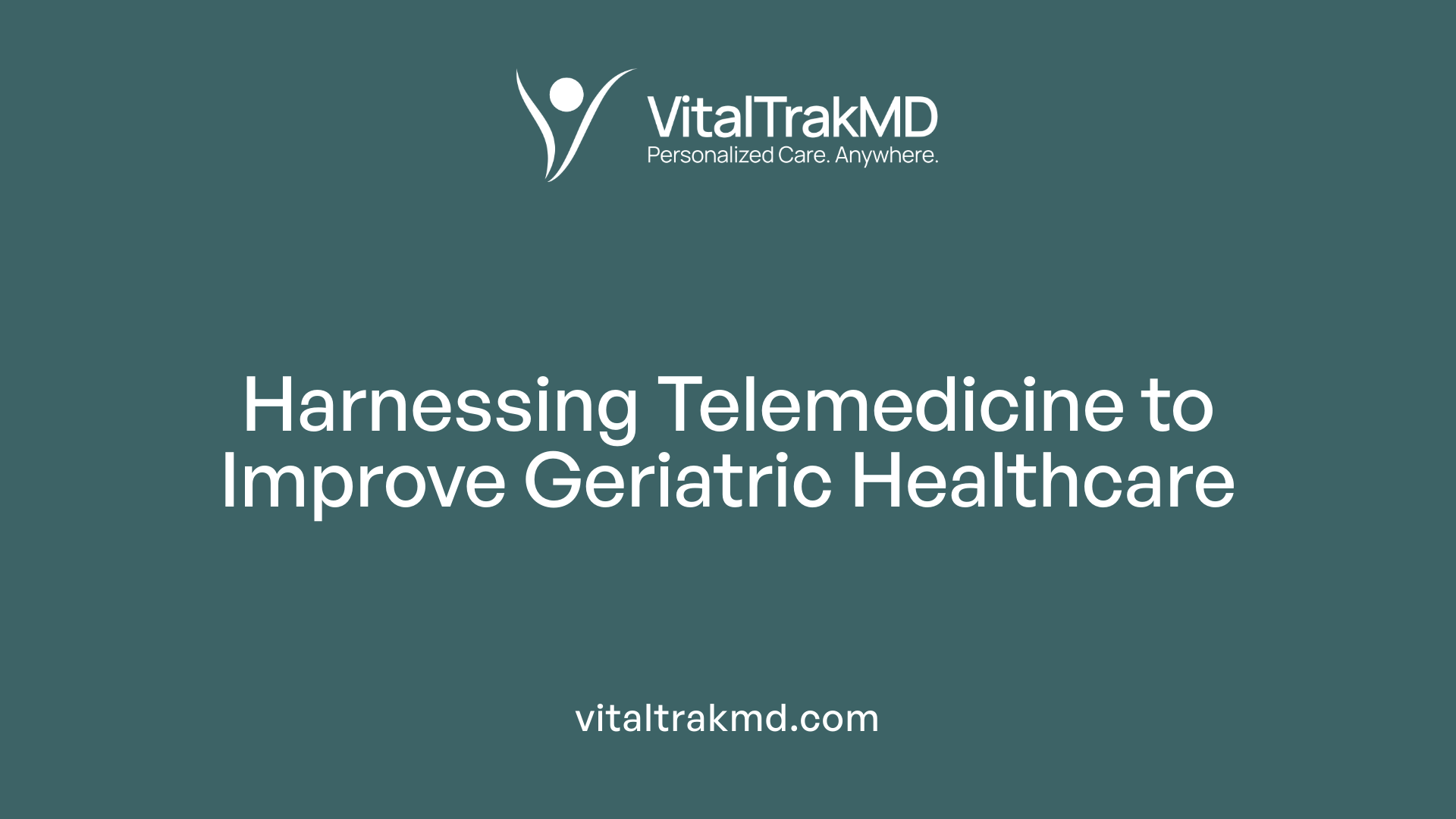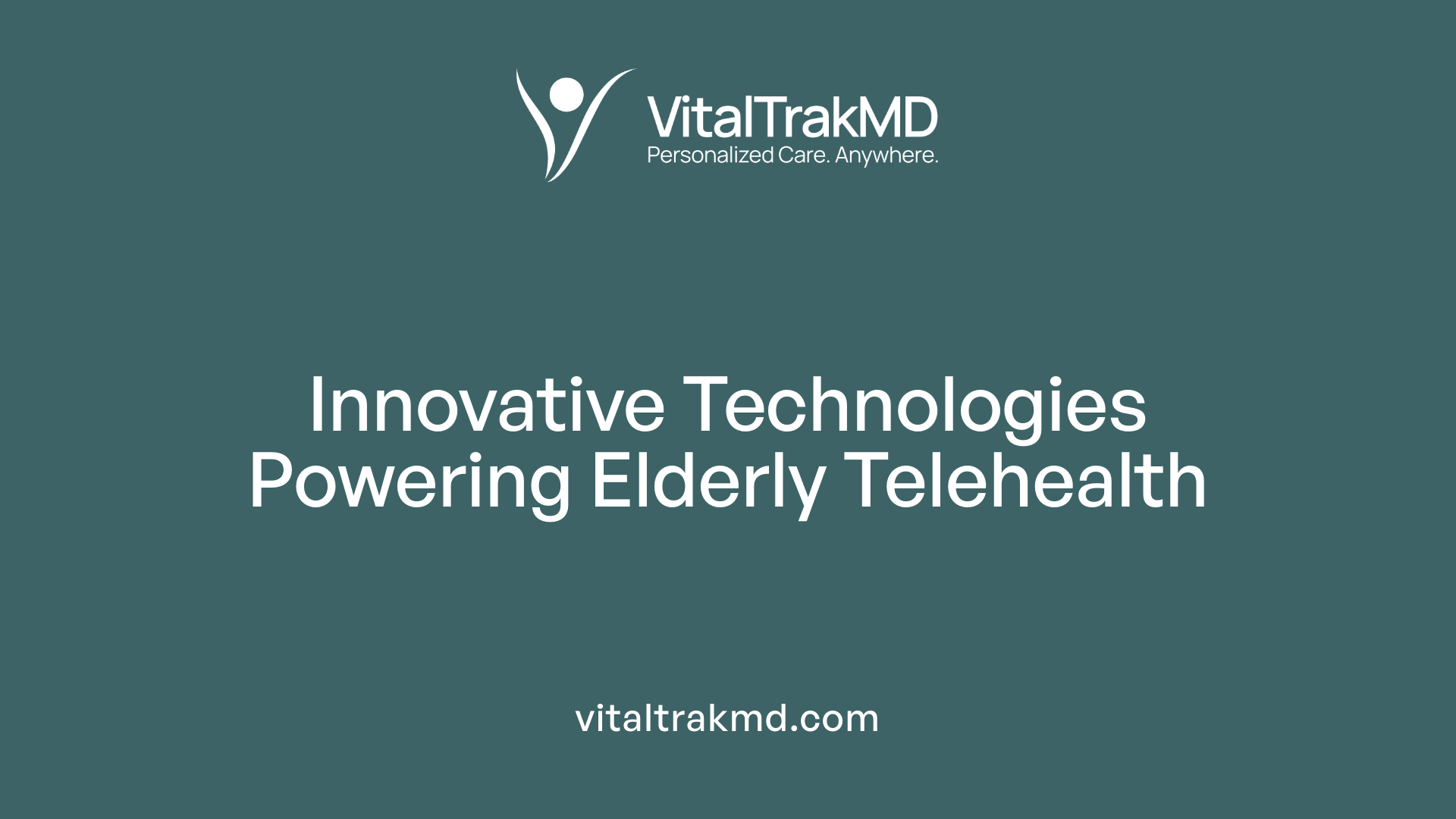Using Telemedicine to Manage Chronic Illness in Seniors

Transforming Senior Healthcare Through Technology
With nearly 75% of older adults living with at least one chronic condition, innovative solutions like telemedicine are increasingly vital in managing complex health needs. This article explores how telehealth tools are shaping the future of chronic disease management among seniors, emphasizing effectiveness, perceptions, barriers, and best practices.
Overview of Telemedicine and Its Relevance to Geriatric Care

What is the role of telemedicine in managing chronic illnesses among seniors?
Telemedicine is transforming how healthcare is delivered, especially for older adults managing chronic health problems. It allows frequent virtual check-ins, remote monitoring of vital signs, and real-time consultations, which are crucial for effective disease management. This approach supports better medication adherence, early detection of health changes, and personalized care adjustments, reducing hospital visits and enhancing patients' quality of life.
What common chronic conditions in seniors can be managed through telemedicine?
Many persistent health issues common in the elderly are well-suited for telehealth interventions. These include high blood pressure (hypertension), diabetes, chronic kidney disease, COPD, arthritis, stroke, and even mental health conditions like depression. Regular remote monitoring, coupled with teleconsultations, helps keep these illnesses under control, often preventing complications and hospitalizations.
How is telemedicine integrated into mainstream elderly healthcare?
Telehealth is increasingly embedded into routine geriatric care through various methods such as video visits, remote monitoring devices, and health applications. These tools enable healthcare providers to track health metrics continuously, communicate easily with patients, and involve family members when necessary. As a result, telemedicine enhances accessibility, especially for seniors with mobility challenges or those living in remote areas.
| Aspect | Description | Supporting Technologies |
|---|---|---|
| Monitoring | Automatic transmission of health data | Blood glucose meters, blood pressure cuffs, pulse oximeters |
| Communication | Virtual consultations and messaging | Videoconferencing, secure messaging apps |
| Patient Engagement | Education and lifestyle counseling | Mobile health apps, interactive content |
Telemedicine's expanding role in elderly care not only improves health outcomes but also makes healthcare more accessible and cost-effective, addressing the unique needs of aging populations.
Key Chronic Conditions Managed via Telehealth

What common chronic conditions in seniors can be managed through telemedicine?
Many common health issues among older adults can benefit from telehealth solutions. These include conditions such as hypertension, diabetes, heart failure, COPD, arthritis, and chronic kidney disease. Telemedicine allows for regular monitoring and management without the need for frequent in-person visits. Using remote monitoring devices like blood pressure cuffs and glucose meters, patients can transmit vital data automatically to their healthcare providers, facilitating timely interventions and medication adjustments.
What evidence supports the effectiveness of telehealth interventions for seniors?
Research and systematic reviews emphasize the positive impact of telehealth on managing chronic illnesses among older populations. Telehealth interventions have demonstrated improvements in blood pressure control, better glycemic management, and reductions in hospital readmissions. Patients report higher satisfaction levels due to increased convenience and ease of access, especially for those with mobility challenges or residing in remote areas. Additionally, telehealth enables ongoing education, medication adherence, and lifestyle counseling, ultimately leading to improved health outcomes and enhanced quality of life.
Additional insights on telehealth for chronic disease management
Older adults’ perceptions of telehealth are generally favorable, particularly when the technology is user-friendly and support is available. Though barriers like limited internet access and technological literacy exist, tailored training and simplified platforms can help bridge this gap.
This approach not only alleviates treatment burdens, such as travel and waiting times, but also promotes proactive self-management. As a result, telehealth emerges as a vital component in the modern care of seniors with chronic conditions, continuing to evolve and expand in scope and accessibility.
Technologies Facilitating Telemedicine for Older Adults

What technologies are used to support telehealth for seniors?
Telehealth relies on various innovative technologies to ensure effective remote healthcare delivery for older adults. Key components include remote monitoring devices, videoconferencing tools, mobile health applications, and messaging platforms.
Remote monitoring devices automatically transmit vital health data, making continuous health tracking possible without frequent clinic visits. These include blood glucose meters, blood pressure monitors, and pulse oximeters, which are essential for managing conditions like diabetes, hypertension, and respiratory illnesses.
Videoconferencing tools enable live, interactive consultations between patients and healthcare providers. These sessions mimic face-to-face visits, providing visual cues and direct communication, which are critical for accurate assessments.
Mobile health apps are designed for self-management support. They offer medication reminders, symptom tracking, educational content, and direct messaging with healthcare teams, empowering older adults to take an active role in their health.
Text messaging and online portals facilitate ongoing communication, appointment reminders, and access to health information. They ensure that older adults stay connected with their providers and can easily seek advice or report issues.
How do remote monitoring devices enhance chronic disease management?
Devices like blood glucose meters, blood pressure monitors, and pulse oximeters provide real-time data that is crucial for managing chronic conditions.
By transmitting accurate health metrics directly to healthcare providers, these devices enable timely interventions, medication adjustments, and lifestyle counseling.
This proactive approach helps prevent complications, reduces hospitalizations, and improves overall health outcomes.
| Technology Type | Typical Devices | Main Benefits | Additional Support Features |
|---|---|---|---|
| Remote Monitoring | Glucose meters, BP cuffs, pulse oximeters | Continuous data transmission, early detection | Data integration with electronic health records |
| Videoconferencing | Live or asynchronous video tools | Personal interaction, detailed assessment | Screen sharing, recording options |
| Mobile Applications | Health tracking apps, reminders | Self-management empowerment | Educational modules, communication portals |
| Text Messaging & Portals | SMS alerts, online patient portals | Continuous engagement, quick queries | Personalized alerts, medication management |
Find more about telehealth technologies in elderly chronic illness management
For additional insights and updates on telehealth tools and their application, search the phrase
Perceptions and Acceptance of Telemedicine among Seniors and Healthcare Providers

What are the perceptions, experiences, and acceptance levels of telemedicine among older adults and healthcare providers?
Older adults generally view telemedicine positively, appreciating the increased accessibility, convenience, and reduced need for travel, especially for managing chronic conditions like hypertension and diabetes. Many patients feel more in control of their health and less burdened by frequent hospital visits.
Healthcare providers also recognize the benefits, including the ability to conduct frequent follow-ups, monitor patient health remotely, and provide timely interventions. However, acceptance varies depending on individual factors such as digital literacy, sensory abilities, and prior experience with technology.
Older adults over 75 tend to rely more on audio-only telehealth services due to sensory or technological limitations. Their experiences are often marked by initial challenges learning new platforms but can improve with tailored support. Trust in virtual care increases when patients feel their concerns are acknowledged and when they perceive the technology as useful.
Overall, perceptions are mixed but tend towards positivity when support systems are in place to address barriers, boosting overall acceptance among both seniors and healthcare providers.
What are the barriers and facilitators to adopting telemedicine in senior populations?
Several barriers hinder widespread telemedicine adoption among older adults. These include low digital literacy, sensory impairments like poor vision or hearing, and cognitive challenges that interfere with navigating new technologies. Privacy and data security concerns also can deter use.
Cost remains an obstacle, especially where internet access or suitable devices are not affordable. Additionally, some seniors doubt the accuracy of remote diagnoses, feeling that virtual visits cannot substitute thorough physical examinations.
Facilitators enhancing adoption encompass designing user-friendly interfaces with clear visuals and audio cues, and providing caregiver assistance to help navigate technology. Tailored training sessions on device use and virtual consultation procedures can empower seniors.
Perceived benefits such as reduced travel, increased safety—particularly during COVID-19—and the convenience of flexible scheduling motivate seniors to try telehealth. Involving family members and community support networks further encourages engagement.
In sum, addressing technological gaps, building trust through clear communication, and emphasizing the convenience and safety aspects can significantly promote telehealth use among the elderly.
The importance of trust and perceived usefulness in telehealth acceptance
Trust plays a crucial role in seniors’ willingness to engage with telemedicine. Patients need confidence that virtual visits are secure, private, and capable of addressing their health needs effectively. Healthcare provider communication that emphasizes confidentiality, data security, and the credibility of remote diagnoses boosts trust.
Perceived usefulness also influences acceptance. When older adults believe telehealth will improve their health management, make visits more convenient, and provide reliable support, they are more inclined to embrace the technology.
Successful implementation involves combining user-friendly design, effective communication, and supportive policies that reinforce the value of telehealth. Healthcare providers can foster trust by providing detailed medical summaries, demonstrating virtual examination techniques, and maintaining empathy during online interactions.
By focusing on these aspects, telehealth services can become more widely accepted, ultimately leading to better health outcomes for seniors managing chronic illnesses.
Benefits of Telemedicine for Elderly Patients with Chronic Conditions

What are the benefits of using telemedicine for elderly patients with chronic conditions?
Telemedicine offers numerous advantages for older adults managing chronic diseases. It significantly improves access to healthcare services, especially for those living in remote or underserved areas. Patients can receive timely medical interventions, which are vital for controlling conditions like hypertension, diabetes, and arthritis.
Travel and waiting times are greatly reduced, decreasing the physical and emotional burden often associated with clinic visits. This is particularly beneficial during health crises such as the COVID-19 pandemic, where minimizing exposure risks is essential.
Enhanced disease monitoring is made possible through remote devices that transmit health data automatically. Such tools include blood glucose meters for diabetics, blood pressure monitors for hypertensive patients, and pulse oximeters for respiratory issues. These devices enable more consistent oversight of health status.
Furthermore, telemedicine facilitates better self-management. Patients engage in regular virtual follow-ups, medication reviews, and receive health education, which helps in promoting adherence and lifestyle changes. This continuous care model supports the management of complex, multimorbid conditions common in older adults.
How does telemedicine support medication adherence and lifestyle management?
Through virtual consultations, healthcare providers can review medications, address side effects, and adjust treatment plans promptly. Reminders for medication intake can be integrated into telehealth platforms, enhancing adherence.
Remote monitoring devices allow patients to track vital signs and share data with their doctors in real-time. This ongoing feedback increases awareness and accountability, encouraging healthier behaviors. Education on diet, exercise, and disease management strategies is also delivered effectively in the comfort of home, fostering better lifestyle choices.
By reducing the need for frequent in-person visits and providing a familiar environment for care, telemedicine promotes sustained engagement in health management, ultimately leading to improved clinical outcomes for older adults with chronic ailments.
Evidence Supporting Telehealth Effectiveness in Seniors
What evidence supports the effectiveness of telehealth interventions for seniors?
Multiple studies have confirmed that telehealth significantly improves health outcomes for older populations managing chronic diseases. For instance, systematic reviews show that telemedicine interventions lead to better control of blood glucose levels in diabetic seniors, with HbA1c levels improving notably within 12 months of implementing telehealth services. Similarly, telehealth for hypertensive patients has shown reductions in systolic blood pressure after six months, contributing to lower cardiovascular risks.
In addition to physiological improvements, seniors report higher satisfaction with telehealth. They benefit from increased frequency of contact with healthcare providers, which supports better medication adherence, lifestyle modifications, and early detection of health issues. Virtual monitoring devices like blood pressure cuffs and glucose meters allow continuous tracking, enabling timely interventions that reduce hospital readmissions and emergency visits.
Research also demonstrates improved patient engagement, with older adults feeling more involved and confident in managing their health. Telehealth's convenience helps overcome mobility and transportation barriers, especially critical during the COVID-19 pandemic when in-person visits were limited. Virtual consultations and remote monitoring, combined with tailored health education, foster more consistent and effective chronic disease management.
What are the limitations and future directions of current research?
Despite these promising findings, much of the existing evidence comes from uncontrolled studies or reviews with varying methodologies, leading to inconsistent results across different populations and conditions. Many studies focus mainly on heart failure, leaving gaps concerning other cardiovascular or multimorbidity management.
Furthermore, most research has short follow-up periods, limiting understanding of long-term sustainability of benefits. There is also limited data on how socioeconomic factors, health literacy, and technological literacy influence outcomes and access.
To advance the field, future research should prioritize high-quality, large-scale randomized controlled trials with longer durations and diverse populations. Studies should also examine the cost-effectiveness of telehealth and strategies to address disparities, ensuring equitable access for vulnerable groups. Addressing these gaps will help solidify telehealth as a reliable, long-term solution for senior care.
| Aspect | Current Evidence | Future Needs | Additional Details |
|---|---|---|---|
| Clinical Outcomes | Improved blood sugar and blood pressure | Long-term sustainability | Focus on various conditions and multimorbidity |
| Patient Satisfaction | Increased engagement and confidence | Diverse demographic analysis | Incorporate family and caregiver roles |
| Research Quality | Mostly uncontrolled, short-term | RCTs, longitudinal studies | Emphasize equitable access and health literacy |
This evolving evidence underscores telehealth's potential to transform geriatric care, provided ongoing research addresses current limitations and explores new frontiers.
Implementation Strategies for Telemedicine in Geriatric Care
How can telemedicine be implemented effectively in geriatric chronic disease management?
Implementing telemedicine successfully for older adults with chronic conditions requires a comprehensive approach. Technologies must be designed to be user-friendly, with simple interfaces, clear visual and audio guidance, and devices that accommodate sensory or cognitive impairments common in the elderly.
Training is a crucial step, involving both healthcare staff and patients. Staff education ensures providers are comfortable with remote consultation and monitoring tools, while patient education improves confidence and competence in using telehealth services.
Personalized intervention strategies should consider individual needs, including health literacy levels, technological familiarity, and socioeconomic factors. Tailoring approaches helps ensure each patient’s unique circumstances are addressed, making telehealth a practical part of their ongoing care.
Furthermore, integrating telemedicine into existing healthcare workflows enhances efficiency. This can be done through seamless electronic medical record updates, scheduled follow-ups, and protocols for combining virtual care with periodic in-person visits, especially for physical exams or tests that require hands-on assessment.
What role do caregivers play in telehealth in elderly populations?
Caregivers are vital in supporting older adults' use of telehealth technology. They assist with setting up devices, troubleshooting technical issues, and monitoring health indicators transmitted through remote devices such as blood pressure monitors and glucose meters.
Caregivers also provide emotional support, help patients stay engaged and adhere to treatment plans, and communicate concerns to healthcare providers. Their involvement can significantly improve the effectiveness of telehealth interventions, ensuring older adults receive continuous, comprehensive care.
In cultural contexts emphasizing filial piety or family involvement, caregivers often serve as mediators who help patients navigate the complexities of digital health platforms, thereby enhancing the overall experience and outcomes.
How can interventions be tailored to individual needs?
Effective telehealth programs adapt to each patient’s health status, capabilities, and preferences. For example, older adults with visual impairments may benefit from audio-enhanced interfaces, while those with cognitive challenges might need simplified instructions and device operations.
Assessing individual health literacy levels is critical. Providing education materials that match these levels facilitates better understanding and engagement.
Socioeconomic factors must also be considered. Patients with limited internet access or lacking advanced devices may rely more on audio-only calls or phone-based interventions.
By combining technical adaptations with personalized education and support, telehealth services can become more accessible, acceptable, and effective for diverse elderly populations.
| Aspect | Strategy | Purpose | Additional Details |
|---|---|---|---|
| Technology Design | User-friendly interfaces, visual and audio cues | Facilitate ease of use for elderly | Careful choice of devices that accommodate sensory deficits |
| Training and Support | Hands-on training, instructional materials, caregiver involvement | Increase competence and confidence | Tailored education based on individual tech familiarity |
| Personalization | Adjusting for health literacy, cognitive status, socioeconomic background | Enhance engagement and adherence | Use of simplified language, culturally sensitive materials |
| Healthcare Workflow Integration | Combining virtual and in-person visits, electronic records update | Improve consistency, continuity of care | Clear protocols for transition points, physical examination |
Effective implementation of telehealth in geriatric care hinges on adaptable, accessible, and well-supported systems that prioritize each patient's unique context, ensuring technology enhances rather than complicates chronic disease management.
Reducing Treatment Burden Through Telehealth
How effective is telehealth in reducing treatment burden for seniors with chronic illnesses?
Telehealth has proved to be a valuable tool in easing the treatment burden faced by older adults managing chronic diseases such as arthritis, hypertension, and diabetes. By facilitating remote monitoring and virtual consultations, it minimizes the need for frequent hospital visits and physical travel, which can be especially challenging for seniors with mobility issues. For example, telehealth enables patients to use devices like blood pressure monitors or glucose meters at home, transmitting data directly to healthcare providers for continuous oversight. This proactive approach allows for early intervention and medication adjustments without the stress of in-person appointments.
Moreover, the ability to connect with healthcare providers through video or phone reduces transportation costs, waiting times, and physical discomfort. Regular virtual check-ins support medication adherence, reinforce lifestyle counseling, and empower older adults to participate actively in their health management. Systematic reviews underline that such frequent contact improves clinical outcomes, such as better blood pressure control and glycemic levels, and also enhances psychological well-being.
What are some benefits of telehealth in minimizing physical and emotional stress?
For many seniors, managing chronic conditions involves ongoing stress related to frequent hospital visits, complex medication routines, and navigating healthcare systems. Telehealth can alleviate these pressures by providing a more comfortable and less intimidating environment for care. Seeing healthcare professionals from home reduces travel-related fatigue and exposure to infectious risks, such as COVID-19, which older populations are particularly vulnerable to.
In addition, virtual care fosters emotional support by maintaining continuous contact with healthcare providers and involving family members when appropriate. Such involvement helps in managing mental health issues common among seniors with chronic illnesses, like depression or anxiety. Furthermore, the convenience of managing health digitally can improve overall quality of life, increase feelings of control over one’s health, and decrease feelings of isolation.
What barriers might increase treatment burden when implementing telehealth?
Despite its benefits, telehealth implementation can sometimes inadvertently increase treatment burden if not carefully designed. Challenges such as sensory impairments (vision or hearing difficulties), cognitive issues, and low digital literacy can hinder effective use of telehealth services. Older adults unfamiliar with technology may find virtual platforms confusing or intimidating, leading to frustration, reduced engagement, and potential neglect of care routines.
Additionally, technical problems like poor internet connectivity or complex device interfaces can add to the stress rather than alleviate it. If healthcare providers do not tailor telehealth approaches to individual capabilities and needs, these barriers can create additional emotional and cognitive strain. Therefore, providing adequate technical support, simplifying user interfaces, and offering training are crucial steps to ensure telehealth reduces, rather than increases, the overall treatment burden for seniors.
Guidelines and Best Practices for Telemedicine in Senior Care
What are the current guidelines and best practices for utilizing telemedicine to manage chronic diseases in seniors?
Implementing telehealth effectively in senior care requires a strategic approach that focuses on several important areas. First, it’s essential to prepare both patients and caregivers. This includes providing clear instructions, educational resources, and support to help them understand how to use telehealth tools confidently.
Designing tools and platforms that are user-friendly and accessible is equally important. This means employing simple interfaces, clear visuals, audio guidance, and devices compatible with sensory and cognitive needs common among the elderly. For example, large fonts, straightforward navigation, and minimal setup requirements can significantly enhance usability.
Routine evaluation and obtaining feedback from users help identify technical or process issues and improve service quality. Regular check-ins and surveys can ensure that the telehealth system remains effective and user-centered.
Lastly, culturally sensitive communication practices are vital. Tailoring interactions to respect language differences, health literacy levels, and cultural values fosters trust and encourages ongoing engagement. Overall, these principles—preparation, accessibility, continuous assessment, and sensitivity—are fundamental to maximizing the benefits of telehealth for seniors managing chronic conditions.
How should providers address technological and individual challenges?
Healthcare providers should proactively support seniors in overcoming technological hurdles by assisting with device setup and offering hands-on training sessions. Educating patients and their caregivers on navigation, data sharing, and troubleshooting minimizes anxiety and technical failures.
Adapting communication styles is also crucial. This may involve speaking slowly, using simple language, and confirming understanding during virtual visits. Moreover, providers should incorporate patient and caregiver feedback to tailor services and address specific concerns.
Recognizing individual challenges such as sensory impairments or cognitive decline means offering alternative solutions. For example, leveraging audio-only options or providing written summaries can bridge gaps.
By combining technological assistance, personalized support, and ongoing feedback, providers can enhance the telehealth experience for seniors, leading to better health outcomes and increased satisfaction.
Impact of Telehealth on Patient Outcomes and Healthcare Systems
What impact does telehealth have on patient outcomes and healthcare delivery for elderly patients with chronic illnesses?
Telehealth has demonstrated significant benefits in managing chronic diseases among older adults. It improves clinical outcomes by enabling frequent monitoring and early intervention, which can reduce hospitalizations and emergency visits. For example, home blood pressure monitoring coupled with telehealth support has led to better blood pressure control in hypertensive patients.
Furthermore, telemedicine facilitates continuous care, essential for conditions like diabetes and heart failure. Systematic reviews show that telehealth interventions can improve medication adherence, manage blood sugar levels, and even positively influence mental health in patients with rheumatoid arthritis.
Despite these advantages, challenges persist. Disparities in access to technology, health literacy, and socioeconomic factors mean not all elderly patients benefit equally. Ensuring that older adults, especially those with low digital literacy, can access telehealth services is critical for equitable health outcomes.
How can healthcare systems leverage telemedicine to improve long-term care?
To maximize telehealth's potential, healthcare systems should embed it as a standard component of long-term and chronic care strategies. This involves developing integrated platforms that support virtual consultations, remote monitoring, and real-time data sharing among multidisciplinary teams.
Addressing technological disparities is vital; providing digital literacy education and user-friendly devices can increase adoption among older populations. Policies that promote equitable access, such as subsidized internet services and support services, are also necessary.
Furthermore, designing protocols that combine telehealth visits with periodic in-person assessments can help manage physical examinations and laboratory testing needs. Incorporating caregivers and family members into virtual care can enhance engagement and support.
By fostering collaboration across healthcare providers and investing in robust digital infrastructure, healthcare systems can promote sustained, effective management of chronic conditions in seniors, ultimately improving health outcomes and reducing healthcare costs.
| Aspect | Description | Additional Notes |
|---|---|---|
| Clinical impact | Improved disease control, reduced hospitalizations | Especially effective for hypertension, diabetes, heart failure |
| Cost efficiency | Reduced travel and infrastructure costs | Savings for healthcare providers and patients |
| Care continuity | Enables regular monitoring and follow-up | Facilitates multidisciplinary approach |
| Disparities | Access and literacy barriers | Need for targeted support and education |
| Strategies | Integration with in-person care; caregiver involvement | Tailoring solutions to older adults' needs |
Addressing Disparities and Promoting Equity in Telehealth
What disparities exist in telemedicine use among seniors, and how can they be addressed?
Research shows that there are notable differences in telehealth utilization among older adults, influenced by factors such as age, income level, education, and digital literacy. For instance, individuals over 75 years old tend to use audio-only modalities more frequently, often due to sensory, cognitive, or technological challenges. Additionally, older adults with lower socioeconomic status and limited access to reliable internet or devices are less likely to engage in video-based telehealth services.
To bridge these gaps, strategies include designing user-friendly telehealth platforms that accommodate visual and auditory limitations. Tailored educational programs can improve confidence and skills in using digital technologies. Policy and infrastructure improvements, such as expanding broadband access in underserved areas, are essential. Community-based programs and partnerships with local organizations can facilitate outreach and digital literacy training, fostering greater inclusion.
What role does health literacy play in successful telehealth adoption?
Health literacy—the ability to understand and act upon health information—is vital for effective telehealth use. Patients with higher health literacy are more likely to comprehend health data, trust digital health services, and actively participate in their care. Conversely, lower health literacy is associated with reduced engagement and potential misuse of telehealth resources.
Improving health literacy involves clear communication, simplified educational materials, and supportive guidance tailored to individual needs. Providing information in multiple languages, using visual aids, and involving caregivers can enhance understanding. When patients are knowledgeable about their health and how to use telehealth tools, they are more confident, leading to better adherence and outcomes.
Strategies to promote telehealth equity among seniors
Efforts to foster equity in telehealth include integrating culturally sensitive interventions that consider language, cultural norms, and societal values. Developing programs that involve family members or community leaders helps build trust and acceptance.
Policy initiatives should focus on subsidizing devices and internet access for low-income seniors. Healthcare systems can implement training sessions and tech support to improve digital skills.
Furthermore, healthcare providers should adopt flexible communication methods—combining video, audio-only, and in-person visits—to accommodate varied preferences and capabilities. Regular assessment of barriers and ongoing engagement are essential for continuous improvement.
| Disparity Factors | Solutions | Additional Notes |
|---|---|---|
| Age-related limitations | User-friendly interfaces, training | Focus on seniors over 75 |
| Socioeconomic status | Devices subsidies, internet expansion | Target underserved communities |
| Digital literacy gaps | Education programs, caregiver support | Enhance confidence and skills |
| Cultural and language barriers | Culturally tailored education, multilingual support | Foster trust and comprehension |
| Infrastructure and access | Policy support, community outreach | Ensure equitable resource distribution |
By applying these comprehensive approaches, the goal is to make telehealth an inclusive and effective tool for managing chronic conditions in all older adults, regardless of their socioeconomic or technological background.
Future Directions and Innovations in Telemedicine for Seniors
What are the future prospects of telemedicine in senior healthcare?
The future of telemedicine in senior healthcare looks promising, driven by technological advancements like the Internet of Things (IoT), artificial intelligence (AI), and sophisticated data analytics. These emerging tools allow for more personalized and proactive health management, enabling healthcare providers to monitor older patients continuously and intervene early.
Integrating AI algorithms can help predict health deterioration, customize treatment plans, and improve diagnostic accuracy. Meanwhile, IoT devices such as wearable sensors and smart home systems will offer real-time health data, simplifying ongoing disease management and enhancing seniors' independence.
Ongoing research, combined with supportive healthcare policies, is essential to overcoming current limitations and establishing telehealth as a standard aspect of geriatric care. This evolving landscape aims to reduce hospitalizations, improve quality of life, and facilitate aging-in-place strategies.
How can innovations further reduce treatment burden and improve outcomes?
Technological innovations like advanced wearable sensors, predictive analytics, and seamless connectivity will significantly lessen the ongoing treatment burden for older adults. These tools enable early detection of health issues, reducing the need for emergency interventions and hospital stays.
For example, wearable devices that monitor vital signs can alert providers to concerning trends, prompting timely adjustments to medication or lifestyle recommendations. Predictive analytics can identify at-risk individuals based on accumulated health data, personalizing prevention and treatment strategies.
Additionally, improved connectivity facilitates effective remote consultations, enhances patient engagement, and supports medication adherence through automated reminders and educational interventions. Ultimately, these innovations will empower seniors to manage their health more independently, fostering a greater sense of control and improving overall outcomes.
What are the implications for healthcare policy and care models?
To maximize the benefits of these technological advances, policymakers need to develop regulations that promote equitable access, data security, and quality standards. These include investing in broadband infrastructure, subsidizing digital devices for underserved populations, and establishing clear guidelines for telehealth services.
Care models will evolve to incorporate hybrid approaches blending in-person and virtual visits, with remote monitoring becoming a routine component of chronic disease management. Care coordination models will leverage digital platforms to facilitate multidisciplinary collaboration, ensuring comprehensive and continuous care.
Furthermore, training healthcare professionals and educating older adults about new technologies are vital steps toward embedding telehealth deeply into standard care practices. As policies adapt, telehealth can shift from an optional service to a core element of age-friendly, patient-centered care.
How will integration of telehealth into standard healthcare improve long-term outcomes?
Embedding telehealth into routine care offers numerous advantages, including improved access, reduced costs, and enhanced patient engagement. Regular virtual visits and remote monitoring enable ongoing assessment, early intervention, and better management of chronic conditions.
This integration supports a holistic approach to health, addressing physical, mental, and social well-being. It also fosters stronger relationships between patients and providers, with increased touchpoints that reinforce adherence and lifestyle modifications.
In the long term, a systematic telehealth framework can lead to lower morbidity and mortality rates among older adults, reduced healthcare system strain, and more personalized, efficient care pathways. These benefits collectively contribute to healthier aging populations and more sustainable healthcare systems.
Harnessing Digital Innovation for Better Elderly Care
Telemedicine stands as a transformative force in geriatric care, improving access, outcomes, and satisfaction for seniors managing chronic illnesses. By addressing barriers and adhering to best practices, healthcare systems can fully realize its potential to foster healthier, more independent aging populations.
References
- Telehealth for chronic conditions
- Telemedicine can revolutionize the treatment of chronic ...
- Telehealth Interventions to Improve Chronic Disease
- Telehealth utilization among patients with chronic disease
- Telemedicine application in patients with chronic disease
- Designing Telemedicine for Older Adults With Multimorbidity
- How can I use telehealth to manage chronic conditions?
- The Role of Telemedicine in Geriatric Healthcare
- The relationship between treatment burden and the use of ...
Recent articles
Want to Feel Better and Live Healthier?
Join hundreds of patients taking control of their health with personalized care that fits their life – not the other way around.
Rated 4.8/5 by 32+ customers







